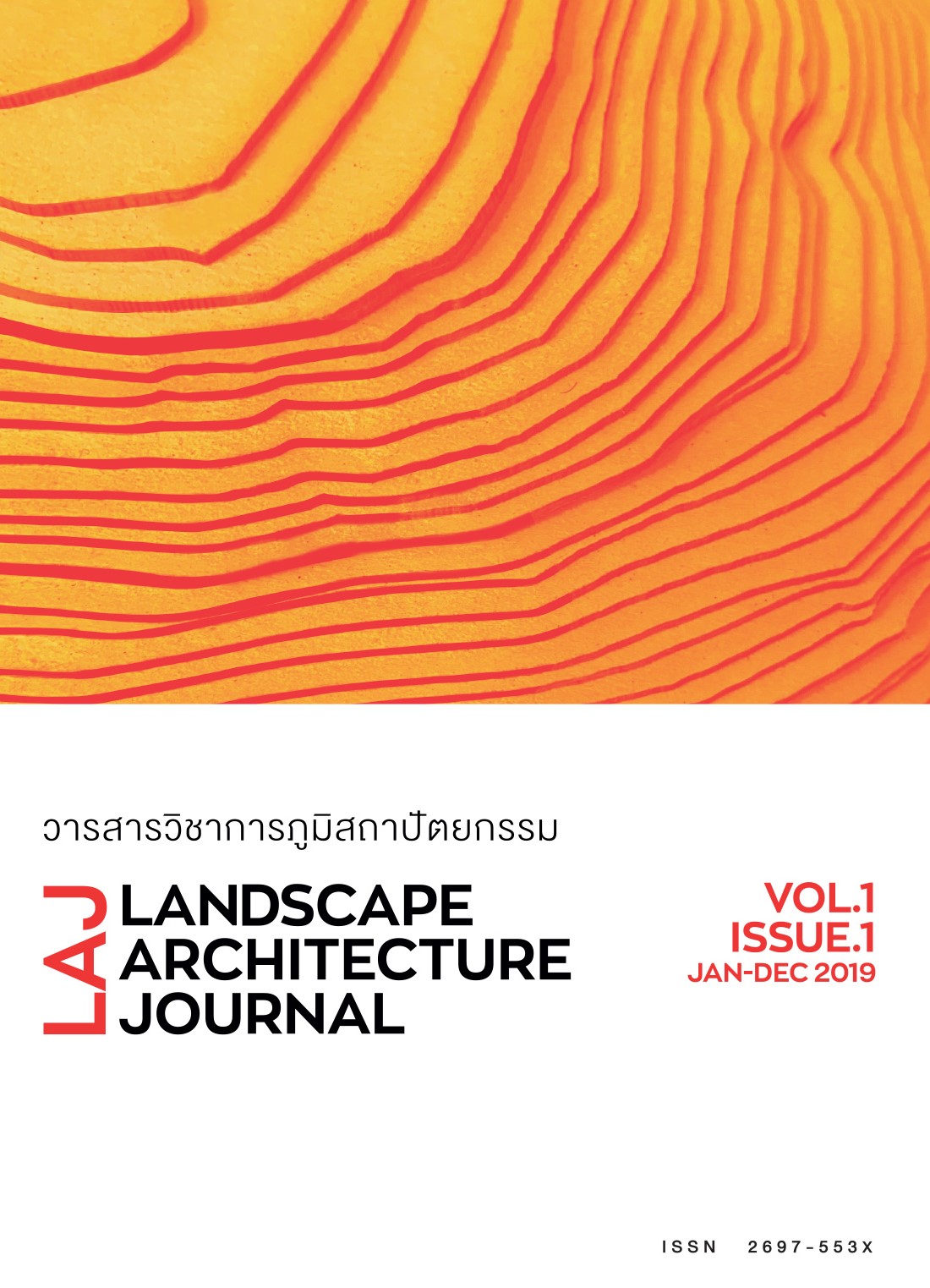Discovery Learning of the Students in Landscape Architecture: Case Studies of Landscape Architectural Design Practice
Main Article Content
Abstract
Based on the Theory of Learning by Discovery introduced by Jerome S. Bruner (1961), the researcher intended to apply the mentioned theory with the third-year students learning Landscape Architecture by means of Studio Teaching. This approach consisted of 4 steps, namely, surveying contexts and environments, analysis and synthesizing data, and finally developing an idea into a suitable landscape design to practice creating a conceptual model. The teaching focused mainly on the development of the learners’ ability and skills to learn, to understand and to create a learning process to use as a tool to discover knowledge by themselves. This theory of learning is based on two assumptions: iconic representation and symbolic representation developments.
The target samples of this study were third-year students, who were learning P. 332: Landscape Architecture and selected by means of a purposive sampling technique. The course of study using Studio Teaching Approach had both lectures on theories and practicum parts, and students’ tasks were examined individually by the instructor (researcher) and the students. There were 2 parts of research tools. One was learning skills through drafting development process, a set of questionnaires. This study was expected that the Discovery Learning in Landscape Architecture would help the students initiate their skills with environments by themselves to develop their landscape architecture furfure and a set of questionnaires.
The results of the study were as follows: Firstly, it was found that the students made use80% of their thinking development as a tool to discover their knowledge in the stage of drafting landscape architecture design, and used 20% of their symbolic development showing drafting symbols via thinking process to communicate with their instructors quickly. As a result, their designs were very good. In addition, the results of symbolic development through design drafting could help to explain the exchange of their ideas and could be used significantly as a tool for them in learning landscape architecture design.
Article Details

This work is licensed under a Creative Commons Attribution-NonCommercial-NoDerivatives 4.0 International License.
References
ฐิติวัฒน์ นงนุช. (2557). รายงานวิจัยเพื่อพัฒนาการเรียนการสอน เรื่อง ผลของการจัดการเรียนรู้โดยใช้ปัญหาเป็นฐานที่มีต่อการพัฒนาด้านแนวความคิดในการออกแบบสถาปัตยกรรม สำหรับนักศึกษารายวิชา ARC417 การออกแบบสถาปัตยกรรมชั้นสูง 2. กรุงเทพฯ: คณะสถาปัตยกรรมศาสตร์ มหาวิทยาลัยศรีปทุม.
พรรณี ชูทัย เจนจิต. (2538). จิตวิทยาการเรียนการสอน (พิมพ์ครั้งที่ 4). กรุงเทพฯ: คอมแพคท์พริ้นท์.
รักตระกูล ใจเพียร, และต้นข้าว ปาณนิท์. (2558). พฤติกรรมการเรียนรู้กับสถาปัตยกรรม. Veridian E-Joumal,
Silpakorn University ISSN 1906 - 3431 ฉบับภาษาไทย สาขามนุษยศาสตร์ สังคมศาสตร์และศิลปะ, 8(3), 1143.
สริตา บัวเขียว. (2559). Scaffotding...ช่วยเสริมสร้างการพัฒนาการเรียนรู้อย่างไร วารสารมนุษยสังคมปริทัศน์, 18(1), 1-16.
สมชาย รัตนทองคำ. (2556). เอกสารประกอบการสอน 475 788 การสอบทางกายภาพบำบัด. ขอนแก่น: ภาควิชากายภาพบำบัด คณะเทคนิคการแพทย์ มหาวิทยาลัยขอนแก่น.
Bruner, J. (1961). Theory of Development: Discovery Learning & Representation. Retrieved from https://study.com/academy/lesson/jerome-bruners-theory-of-development-discovery-learningrepresentation.html
Bruner, J. (1966). Bruner and the Process of Education The Encyclopedia of informal Education. Retrieved from http://infed.org/mobi/jerome-bruner-and-the-process-of-education/.
Gilbert, John V. (2019). Constructivism: Learning by Doing A Spiral Approach to Curriculum. Retrieved from https://www.nyu.edu/classes/gilbert/musedtechwkshp/learn.html

